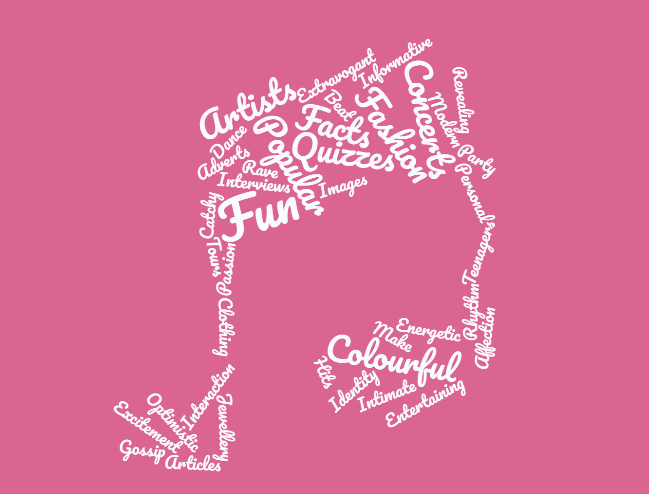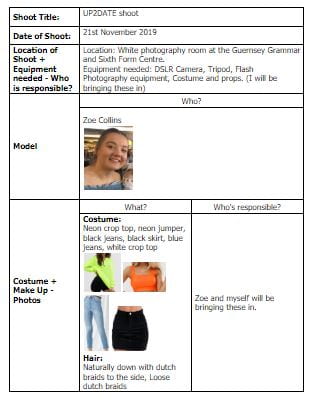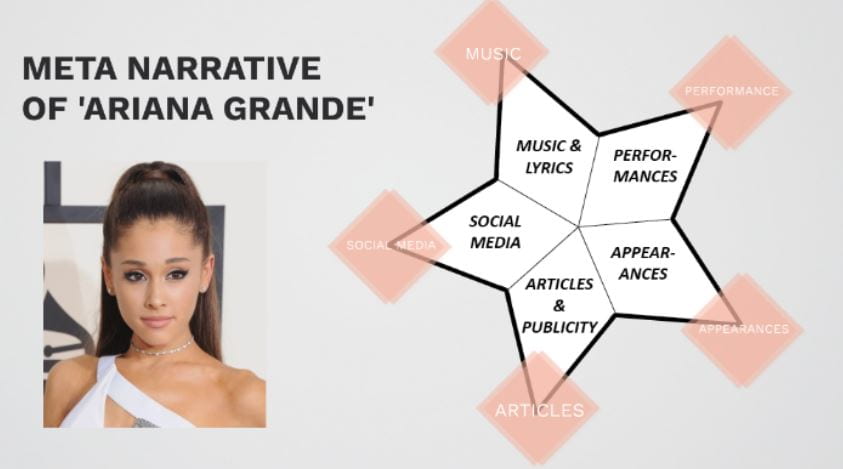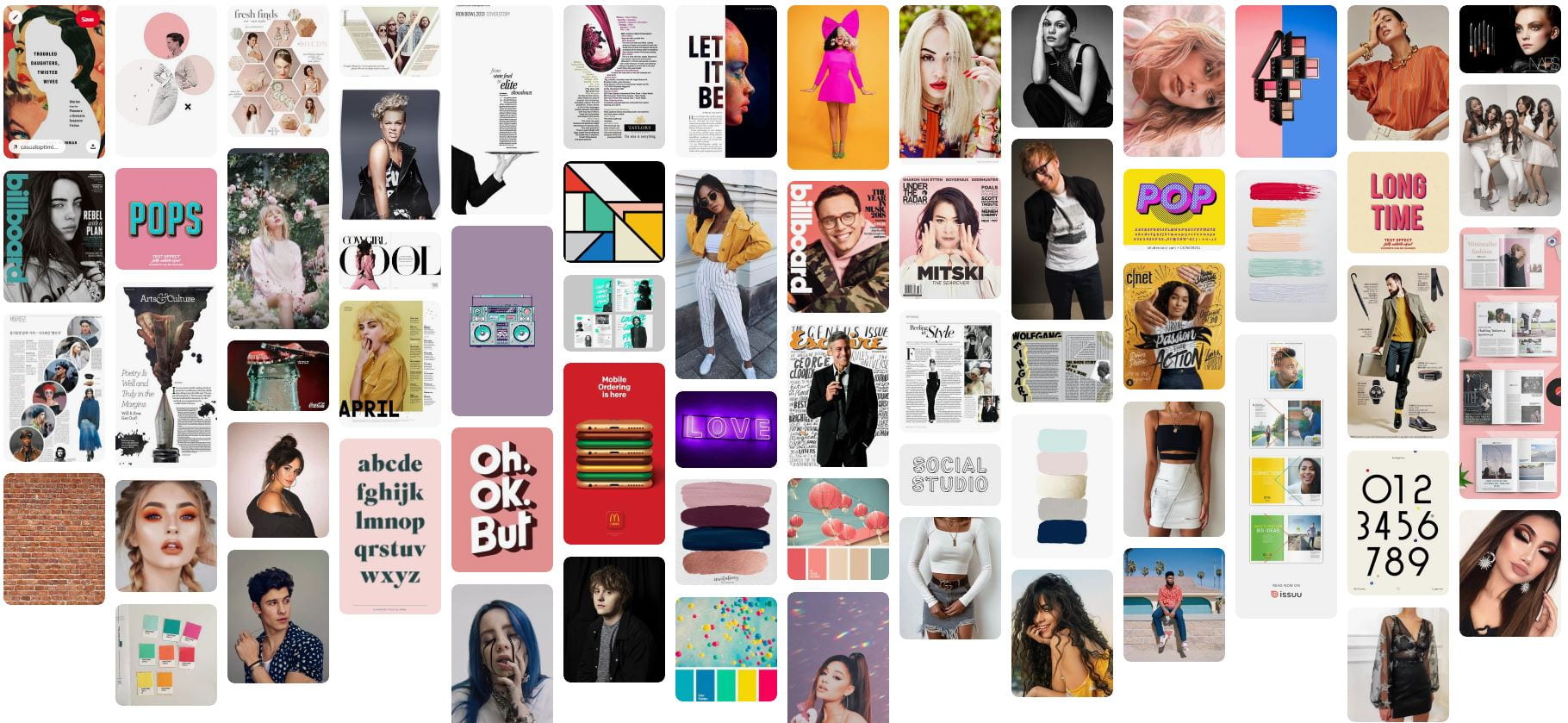Below is a plan of the different elements that will be included in my shoot. I have included how my model will look, the props we will use and the directions I will give her.
Category Archives: Music Magazine
So what am I up against?
Below is a slide show with a voice over explaining what I am up against in the market and the features that they include. I have also added what I will include to make it unique compared to other magazines out there. This will allow my audience to be intrigued in my magazine, hopefully leading them to purchase it.
Mast Head Designs
Here are some Mastheads for my music magazine that I have created and tested out using In Design:

I have used a range of different fonts including Serif, Sans Serif and Decorative. I personally feel (as well as a peer) that the Serif font does not work very well as it does not fit in with the pop genre very well. This is as it seems too formal and isn’t exciting enough. The Sans Serif fonts are quite good as they are very bold and easy to read. This would be successful for a masthead as that is exactly what you want; so that your customers are attracted to your magazine. However, I believe that the decorative fonts (the ones with lots of lines) are my favourite as although they are interesting, they are still very easy to read. I also like the number 2 being coloured yellow or magenta so that it adds excitement for the audience. This fits in with the genre very well without it being too tacky or too colourful. Other colours I tried were less successful. For example, the blue wasn’t really appropriate for the genre so possibly wouldn’t attract consumers to look at the magazine and the pale pink wasn’t bright enough to catch the attention of readers. I would not use these colours for my final masthead design.
Star Image – theirs and mine
Star image is the overall idea created about a specific star. It will take into consideration what they like to get up to to the type of magazines they feature in. Star image is important for celebrities as it is what their fans base them off.
Below is the Meta narrative of Ariana Grande (someone who I may include in my Music Magazine). I have looked at the music she writes, her performances, where she appears on, why and where she appears in magazines and newspapers and the media she uses to connect with her fans. I have then stated what type of character this then represents her as to her fans.
Ariana Grande is a very good example of Richard Dyer’s theory. She is a paradox where on one hand she is this extraordinary music artist that travels around the world performing in concerts, however on the other hand, she is just an ordinary person; she is a 26 year old woman who enjoys hanging out with her friends and having a good time.
After looking at Ariana Grande’s star image, I then constructed a mood board with the kind of pop star look I will use in my magazine for my models. I have included the type of person, hair styles, make up, jewellery and the clothing they would wear. I have used connotations to discuss the type of image this would create for my audience.
Using this mood board (and taking into consideration Mise en Scene and photography techniques as well), I will be able to construct my model into the “perfect” pop music star. These images used in my magazine, will then be able to encode the pop genre which my audience will then decode when reading it. This will hopefully lead them into being intrigued in my magazine which will hopefully lead them into buying it.
Communicating my Brand
On Pinterest, I created a mood board with all of the ideas on pop music. I have added:
- Music Artists
- Fonts
- Colour Swatches
- Magazine Layouts
- Makeup
- Outfits
- Adverts
When creating my magazine, I will then encode these details which my audience will then decode when reading my media. All of these different components will add to the pop genre and make it unique compared to others; hopefully making my magazine more preferable over other pop magazines.
My Audience Profile
Below is a profile of someone that would typically listen to pop music. It includes their hobbies and interest, their artist, clothing, food, show and brand preferences, and the type of people they actually are. Although this is a profile on a female aged 16, I discovered that the target audience can be either gender of Generation Z’s (teens and young adults) however it will be targeted more towards females.
From this information I have discovered, I will be able to use it to encode specific components that when my audience decode my magazine it will interest them and they will accept it as their preferred reading. (If my media did not meet their needs and likes, they may oppose and reject it, making my magazine unsuccessful.) After catching the interest of my target audience, they will hopefully take action into buying my media. This should then lead them to being entertained, informed, receiving social interaction from their favourite celebrities and being able to receive styles that can mould their personal identity.
To grab their attention, I will need to include things such as:
- Music artists listed in the profile
- Clothing being worn from their favourite stores or brands
- Interviews from their favourite celebrities
- Adverts on their favourite brands or shows
- Possibly a competition to their favourite holiday destinations
Branding Ideas + Mission Statement
I have chosen to create a music magazine based on the genre of “Pop”. I thoroughly enjoy this type of music as it offers an escape from my busy lifestyle. It creates enjoyment and allows me to relax which I hope my magazine will also do.
I have decided to name my magazine “UP2DATE” as it is quite catchy and not too complicated. It allows the audience to know that the magazine will include current and modern trends in music and the use of the number 2 gives the idea of text talk (relating to the target audience of Millennial’s and Generation Z’s).
Below if a word cloud with the connotations relating to Pop Music and the type of things I will include in my magazine.

MISSION STATEMENT
UP2DATE thrives in promoting pop music through the current trends to those with a passion in pop. Looking at the new artists, fashion, top hits, hot gossip and your favourite celebs, we aim to inform, entertain, and develop readers and keep you up to date and involved with the latest news.
A Front Cover Analysed
Below shows a music magazine I have analysed. I have looked at the price, demographics, psychographics, the mission statement, and what is actually on the magazine.
Looking at everything which goes into a music magazine, it has shown me how much I need to research before starting to make my own. I will need to look at the demographics and pyschographics of my target audience to determine what I will need to include to interest them. I will also need to think about Mise en Scene and any photography techniques when taking the pictures used on it. All of this must collaborate perfectly in order for my magazine to be a successful piece of media.
Audience Profiling
Below displays a music magazine which I have researched about to find the intended target audience.
After looking at Mojo’s website and using YouGov.co.uk, I was able to discover more about the Magazine. I determined that the demographics for Mojo magazine was people aged 35 up (mainly Generation X). Men are more likely to read the magazine (with 73.1 % of readers being male) however it isn’t only advertised at men but women as well. The psychographics of the magazine are “for those truly obsessed with music” but with a lot of interests in classical rock. Over the years, Mojo have featured huge musical artists including Queen and the Beatles. With such big main cover stars and lines, this draws in more customers to look at their magazines, increasing the purchases of their media.
From investigating Mojo magazine, it has shown me how important it is to take an interest in your target audience and research them thoroughly. It allows you to plan out your magazine and cover to what your audience want and what is appropriate for them.
For example, if you were to create a music magazine based on opera, your demographics are most likely to be the older generation (probably baby boomers), with the psychographics of people who love classical opera music. You music magazine would then need to cater for that group of people and represent that genre. The front cover may still be conventional, however the language used may be sophisticated with an elegant font for the main cover line. You will then have a well known opera singer (e.g Andrea Bocelli) as your main cover star to draw in the attention of your target audience and then you may have insets to advertise more opera singers featured inside your magazine. This will all attract the specific target audience (of the older generation who love opera) however if you were to include bad language or a picture of a rapper, this would not draw in that segment of audience.
This shows me why researching your specific target audience is so important as you need to know what their interests and conventions are. If something isn’t what they are interested in, then your magazine will not attract them. When creating my own music magazine, I will need to decide on the target audience I am aiming it at and then research them to discover what I should then use to draw in their attention.
Conventional design features of a magazine
Most successful magazines all have the same or very similar conventions. These conventions include:
- Main cover line
- Main cover stars
- Masthead
- Cover lines
- Insets
- Captions
- Plug
- Pug
- Issue/date
- Price
- Bar code
Below shows a magazine labelled with the conventions most magazines contain.

Although this magazine contains most of the components, it isn’t as conventional as other magazines. For example, the masthead isn’t as big as it could be; especially compared to others. This could effect how well it grabs the attention of the audience. This magazine also doesn’t contain a pug. A pug is a promotion for something included inside the magazine. (for example: “30 must see movies!”)
From analysing the technical conventions of a music magazine, it has shown me that although magazines can be based on very different genres, they are all constructed in quite similar ways. The more conventions included, the better the magazine is at catching the attention of the audience.



